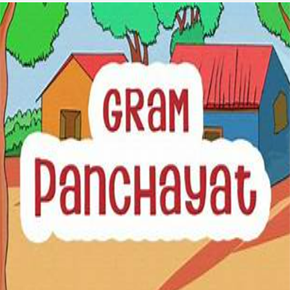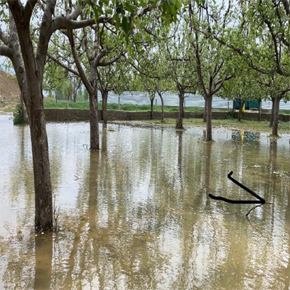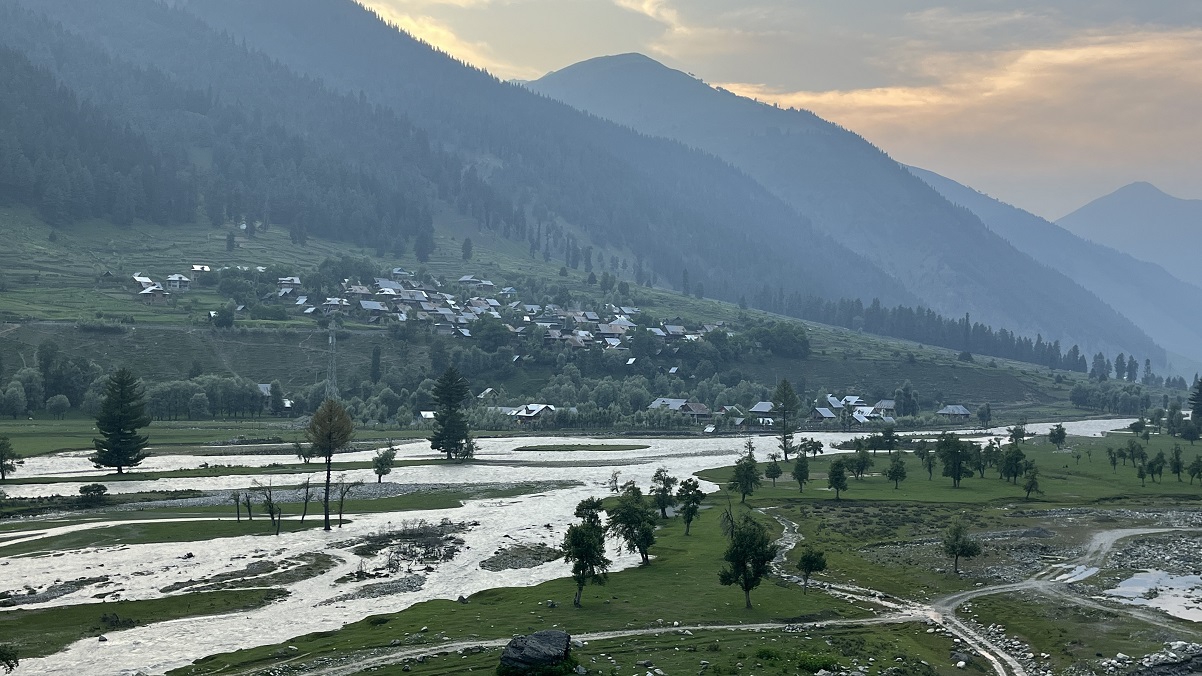Jammu & Kashmir’s rich biological diversity needs to be protected and documented.
Jammu & Kashmir is a treasure trove of herbs which have high medicinal and edible value. These herbs are of great significance to the manufacturing of ayurvedic and unani medicines. Researchers have not fully explored the herbal wealth of Kashmir, and a lot needs to be done in this field. I never knew Aesculus indica (Handoon), which used to be found in abundance in Kashmir valley few decades back, had a medicinal value as well. We have axed a large number of such trees and the same is now an endangered species of trees. In fact very recently dozens of Handoon trees were chopped off near flood channel bund (Solina to Jawahar Nagar). The leaves of Handoon tree are best known for treatment of fever, and the oil extracted from the seed which looks like a Chestnut is used for hair growth and treatment of headaches. Similarly very few of us are familiar with Chari Saban ( Anagallis arvensis) which belongs to Primulaceae family. This plant is used for treatment of ulcers. The crushed plant is applied on affected areas, which has better healing qualities. Nunner and Tchok Chenne are almost extinct now. Kashmiri Mirchi (Marchiwangun) is not seen at all. Our old varieties of apples like Ambri is not available at all. Our traditional sheep, goats and cows are almost extinct. This is a disaster to our Biodiversity? There are hundreds of herbs and other biological resources which are of great importance but only our Hakeems, Vaids and experienced elders have this kind of knowledge. As time runs out the number of people having this traditional knowledge of our bio resources and herbal medicines is also shrinking and a time will come when we won’t have any information about these resources with us. In order to address it we need to document the information these resourceful people have. To institutionalise the same Govt of India enacted Biological Diversity Act also called Biodiversity Act in 2002. This law aims at the conservation of biological resources, managing its sustainable use and enabling fair and equitable sharing of benefits arising out of the use and knowledge of biological resources with the local communities.
Prohibited Activities
The Biodiversity Act prohibits the following activities without the prior approval from the National Biodiversity Authority that has been created at national level.
1) Any person or organisation (either based in India or not) obtaining any biological resource occurring in India for its research or commercial utilisation.
2) The transfer of the results of any research relating to any biological resources occurring in, or obtained from, India.
3) The claim of any intellectual property rights on any invention based on the research made on the biological resources obtained from India. The act envisaged a three-tier structure to regulate the access to biological resources:
4) The National Biodiversity Authority (NBA)
5) The State Biodiversity Boards (SBBs) or Biodiversity Council in case of Union Territories
6) The Biodiversity Management Committees (BMCs) at village , municipalities (towns, cities) & at district level
Biodiversity Management Committees (BMC)
Under Section 41(1) of the Biological Diversity Act, 2002, every local body in the State shall constitute a Biodiversity Management Committee (BMC) within its area of jurisdiction for the purpose of promoting conservation, sustainable use and documentation of biological diversity including preservation of habitats, conservation of land races, folk varieties & cultivars, domesticated stocks and breeds of animals and microorganisms and chronicling of knowledge relating to biological diversity.
The Biodiversity Management Committee (BMC) is to be constituted under section 41(1), shall consist of a Secretary and not more than six persons nominated by the local body, of whom not less than one third should be women and not less than 18% should belong to the Scheduled Castes/Scheduled Tribes. Provided that the members of the committee shall be the proven resident of the local body and their names should be included in the electoral roll of the concerned local body.
The Chairperson of the BMC shall be elected from amongst six nominated members of the committee in a meeting to be chaired by the Chairperson of the local body. The Chairperson of the local body shall have the casting votes in case of a tie. The BMCs are constituted at the local level like village , town or district. The Secretary of the BMC in villages shall be the Panchayat Secretary also called VLW in J&K or any person nominated by the Panchayat Department for Block and District BMCs. The local Member of State Legislative Assembly and Member of Parliament would be special invitees to the meetings of the Committee at State or District level. It is great to see some highly educated persons having been appointed as members of District Biodiversity Council in Pulwama, Budgam, Kupwara, Shopian, Bandipora and other districts. We have educated young members in Kupwara like Nasir Lone, Sulieman Mir. Abdul Bari Andrabi Chairman DDC Pulwama is heading the district Biodiversity Committee as well and Nadeem Qadri environmental lawyer is the Secretary of this committee. In Shopian we have Chowdhary Showkat and Dr Mustafa in Bandipora as BMC members. We have law graduates, MBA pass outs as members of BMC Budgam. This is indeed a great news.
The tenure of the BMC shall be maximum of 05 years and shall be co-terminus with the tenure of the local body, however, the existing BMC shall continue to function, until a new committee is constituted.
BMCs at District Level
In response to official communication by Chairperson J&K Biodiversity Council under letter No: JKUT/BC/BMC/2021-22/521-23 Dated: 7.12.2021, the Chairpersons of District Development Councils in J&K were asked to nominate a seven member team in every district for District Biodiversity Management Committee (BMC). Among these 7 members there has to be one Chairperson, two women members and one member from SC or ST community. A Secretary is also chosen from these members. In most of the districts these committees were constituted on the advice of DDC Chairpersons early this year but formal training has not been given to the members. Some DDC members and Chairpersons have also been elected as members or chairpersons for the district level BMCs. This author has also been elected as Chairman Biodiversity Committee Budgam. Soon after I took over as the Chairperson of this committee in my district, I have been urging the J&K Biodiversity Council Chairperson Dr Mohit Gera who is also the Principal Chief Conservator of Forests (Head of Forest Force in J&K) to organise a training session for the newly elected members and chairpersons of District level BMCs.
Workshop for BMCs
On June 29th the workshop was finally held in Srinagar. Pertinently the Biodiversity Act came into existence after India adhered to the objectives enshrined in the United Nations Convention on Biological Diversity (CBD) 1992. The committee on biodiversity – CBD recognises the sovereign rights of states to use their own biological resources
With an aim of sensitising the Biodiversity Management Committees (BMCs) J&K Biodiversity Council in collaboration with J&K Forest Department organised a “One Day Training program on Biodiversity” at Sher e Kashmir Agriculture University -SKUAST Shalimar recently. The programme was attended by Chairpersons and members of various Biodiversity Management Committees (BMCs) from Kashmir division. The officers of forest department including DFOs, Range Officers and many other field officials also participated in this workshop. The Chairperson of J&K Biodiversity Council who is also the Head of Forest Force in J&K Dr Mohit Gera spoke gave a detailed account of activities of the council to ensure biodiversity conservation and its sustainable utilization. He also highlighted the role of BMCs in Biodiversity Conservation and the need to make them aware of their role and responsibilities. During the panel discussion this author and other panellists made some suggestions like creating master trainers in every district and utilizing services of students and researchers of different universities and colleges at Biodiversity Council , District Committees etc. Dr Mohit Gera accepted this suggestion and said he would carry this forward. He impressed upon BMCs to work with full zeal and dedication and get associated with the updation of People Biodiversity Registers (PBRs). He also spoke about the likely impact of climate change on biodiversity of Jammu & Kashmir and steps required to protect all life forms and create a resilient ecosystem. He along with Additional PCCF Asaf Mehmood who is Secretary of J&K Biodiversity Council impressed upon the BMCs and other participants to create a massive awareness at the grassroots level with respect to biodiversity conservation. It was great to listen to luminaries like Dr Nazir Zeerakh, Prof Anzar Khuroo, Dr Khurshid , Prof Gangoo , Adv Nadeem Qadri , Nazir Be Nazir , Advocate Ab Bari Andrabi and others
Peoples Biodiversity Register-PBR
The main function of the Biodiversity Management Committees (BMCs) is to prepare the People’s Biodiversity Register (PBR) in consultation with the local population. The Register shall contain comprehensive information on availability and knowledge of local biological resources, their medicinal or any other use or any other traditional knowledge associated with them. The BMC shall be responsible for ensuring the protection of the knowledge recorded in PBR, especially to regulate its access to outside persons and agencies. In addition to preparation of the People’s Biodiversity Register (PBR), the BMCs in their respective jurisdiction shall also be responsible for the following :-
A) Conservation, sustainable use and access and benefit sharing of biological resources and eco-restoration of the local biodiversity.
B) Feedback/information to the Board and the National Biodiversity.
C) Authority in the matter of Intellectual Property Right (IPR), Traditional Knowledge and local Biodiversity issues. Management of Biodiversity Heritage Sites including Heritage Trees, Animals/ Micro organisms etc and Sacred Groves and Sacred Water bodies.
D) Regulation of access to the biological resources and/ or associated Traditional Knowledge, for commercial and research purposes. Conservation of traditional varieties/breeds of economically important plants/animals.
E) Biodiversity Education and Awareness building. Documentation, enable procedure to develop bio?cultural protocols.
F) To advise on any matter referred to by the State Biodiversity Board, Biodiversity Councils (in UTs) for granting approval, maintain data about the local Hakeems, Vaids and practitioners using the biological resources.
Conclusion
Dr Mohit Gera -PCCF is the right person to be appointed as the Chairperson of J&K Biodiversity Council. Being head of the Forest Force (HoFF) in J&K he can utilise the services of his forest field staff in creating a massive awareness about our Biodiversity especially the Forest Biodiversity which is of a great importance. Even our forest guards should be sensitised about our Biological diversity. As there are experienced officers available in forest department their services can be utilised along with the services of many BMC members who can become master trainers for implementation of Biodiversity Act in J&K. Former PCCF Mr O P Sharma, the Van Viddhyarthi is the right man to train the master trainers. Govt must arrange exposure trips for master trainers to states where we have vibrant BMCs and Biodiversity Act is being implemented in letter and spirit. The forest department has to take a lead and its officials have to be the campaigners of our Biodiversity as well.

























































































